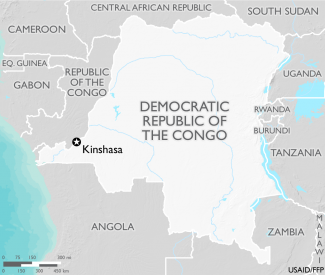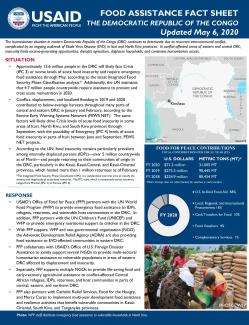May 6, 2020
The humanitarian situation in eastern Democratic Republic of the Congo (DRC) continues to deteriorate due to recurrent intercommunal conflict, complicated by an ongoing outbreak of Ebola Virus Disease (EVD) in Ituri and North Kivu provinces. In conflict-affected areas of eastern and central DRC, insecurity limits income-generating opportunities, disrupts agriculture, displaces households, and constrains humanitarian access.
Situation
- Approximately 13.6 million people in the DRC will likely face Crisis (IPC 3) or worse levels of acute food insecurity and require emergency food assistance through May, according to the latest Integrated Food Security Phase Classification analysis.* Additionally, the UN estimates that 4.7 million people countrywide require assistance to prevent and treat acute malnutrition in 2020.
- Conflict, displacement, and localized flooding in 2019 and 2020 contributed to below-average harvests throughout many parts of central and eastern DRC in January and February, according to the Famine Early Warning Systems Network (FEWS NET). The same factors will likely drive Crisis levels of acute food insecurity in some areas of Ituri, North Kivu, and South Kivu provinces through September, with the possibility of Emergency (IPC 4) levels of acute food insecurity in parts of Ituri between June and September, FEWS NET projects.
- According to the UN, food insecurity remains particularly prevalent among internally displaced persons (IDPs)—over 5 million countrywide as of March—and people returning to their communities of origin in the DRC, particularly in the Kasaï, Kasaï-Central, and Kasaï-Oriental provinces, which hosted more than 1 million returnees as of February.
* The Integrated Food Security Phase Classification (IPC) is a standardized tool that aims to classify the severity and magnitude of food insecurity. The IPC scale, which is comparable across countries, ranges from Minimal—IPC 1—to Famine—IPC 5.
Response
- USAID’s Office of Food for Peace (FFP) partners with the UN World Food Program (WFP) to provide emergency food assistance to IDPs, refugees, returnees, and vulnerable host communities in the DRC. In addition, FFP partners with the UN Children’s Fund (UNICEF) and WFP to provide emergency nutritional support to children in the DRC.
- With FFP support, WFP and non-governmental organization (NGO) the Adventist Development Relief Agency (ADRA) are also providing food assistance to EVD-affected communities in eastern DRC.
- FFP collaborates with USAID’s Office of U.S. Foreign Disaster Assistance to jointly support several NGOs to provide multi-sectoral humanitarian assistance to vulnerable populations in areas of eastern DRC affected by displacement and insecurity.
- Separately, FFP supports multiple NGOs to provide life-saving food and early-recovery agricultural assistance to conflict-affected Central African refugees, IDPs, returnees, and host communities in parts of central, eastern, and northern DRC.
- FFP also partners with Catholic Relief Services, Food for the Hungry, and Mercy Corps to implement multi-year development food assistance and resilience activities that benefit vulnerable communities in Kasaï-Oriental, South Kivu, and Tanganyika provinces.
Food for Peace Contributions
Total Contributions:
| U.S. Dollars | Metric Tons | |
|---|---|---|
| Fiscal Year 2020 | $71.3 million | 31,005 MT |
| Fiscal Year 2019 | $273.3 million | 90,445 MT |
| Fiscal Year 2018 | $224.9 million | 80,434 MT |
* Metric tonnage does not reflect funding for vouchers or cash transfers.
Country-Specific Information
Related Resources


